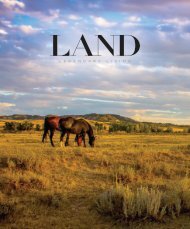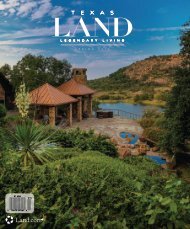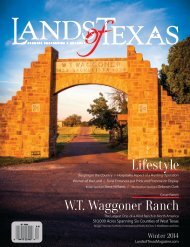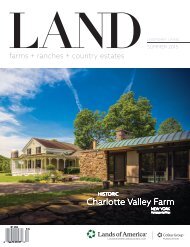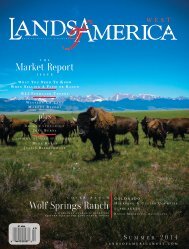Create successful ePaper yourself
Turn your PDF publications into a flip-book with our unique Google optimized e-Paper software.
ADDING VALUE TO LAND<br />
As an added bonus, though, the intangible benefits of<br />
stewardship can also enhance the market value.<br />
“While our primary reason for wanting the ranch wasn’t financial,<br />
a good quail ranch in the Texas Rolling Plains has to increase in<br />
value because there just aren’t that many places to hunt wild<br />
quail,” Campbell said.<br />
Mark Matthews, a partner in Republic Ranches who is also a<br />
wildlife biologist based in Hondo, agreed that focusing on the<br />
‘ecological bones’ of a property can add value, especially if<br />
aesthetics are taken into consideration.<br />
“Good stewardship that improves the quality of the habitat and<br />
the availability of water generally is time and money well spent,”<br />
he said. “Although people may not be able to express why<br />
they are attracted to a piece of property, they respond to the<br />
aesthetics of productivity and of nature.”<br />
In his experience seemingly little things can make a big<br />
difference in the way potential buyers perceive a recreational<br />
property. For instance, potential buyers respond more positively<br />
to a road that winds its way through a stand of bull mesquite<br />
instead of a straight road that is cut through a stand of switch<br />
mesquite. Brush sculpting that leaves a lot of edge trumps more<br />
“artificial” patterns such as checkerboard or strips.<br />
Potential buyers respond more positively to stock ponds that<br />
are built in an irregular shape with the creek drainage curving<br />
around behind as opposed to perfectly symmetrical stock tanks<br />
plopped in the middle of pastures. If the surface water can be<br />
enhanced with a “park-like” setting that includes large trees, it’s<br />
even more appealing. In drought years, he noticed that people<br />
respond to right of ways and riparian areas that is re-seeded<br />
with native plants so there was cover alongside the ranch roads<br />
and creeks hinting at productivity when the rains returned.<br />
“A majority of today’s buyers are looking for recreational<br />
property,” Matthews, who is a Texas Wildlife Association<br />
member, said. “Recreational buyers want the land to offer a<br />
promise of discovery. There are people who want to make the<br />
improvements themselves and then there are those who prefer<br />
to purchase a ‘turnkey’ property to maintain and manage.”<br />
Before joining Republic Ranches, Matthews was involved in a<br />
partnership that sought out ranch properties with the intent of<br />
improving them and reselling them. Their target market was the<br />
people who were searching for a ‘turnkey’ property.<br />
Generally, the partners looked for ranches that had been grazed<br />
continuously and hard with minimal water and infrastructure<br />
development. They considered the soil profile to determine if it<br />
would support diverse vegetation that in turn would support a<br />
species of interest such as white-tailed deer or quail.<br />
“By improving the overall quality of the habitat and the<br />
availability of water, we knew we could enhance the value of the<br />
property most directly,” Matthews said. Location and ease of<br />
access were secondary considerations, he said.<br />
While the partners got satisfaction from improving the land,<br />
it was a business so they began by determining the bottom<br />
line. Before purchasing a property, the partners would define<br />
the top of the local market, estimate the cost of the planned<br />
improvements and see if the difference between the two would<br />
allow them to turn a profit.<br />
“The laws of conformity affect ranch properties just like they do<br />
residential properties,” Matthews said. “You wouldn’t build a<br />
million dollar home in a $250,000 neighborhood. The same holds<br />
true for ranches. When looking at land as an investment, it’s<br />
important to know what the market will bear in a specific region.”<br />
As the partners began to plan their improvements, they would<br />
identify the property’s “sweet spot” whether it was a scenic<br />
water hole, a sandstone cliff, or a stand of ancient live oaks and<br />
make that the focal point. It would be the property’s epicenter<br />
with the improvements radiating from that location.<br />
While the improvements would vary from property to property,<br />
they would be practical applications that enhanced the land’s<br />
productivity such as brush management, range reseeding,<br />
prescribed burning, water development, or the property’s<br />
usefulness such as road and fence construction. Whatever<br />
management practices the partners implemented, they ensured<br />
the property to remain would remain under agriculture or wildlife<br />
tax valuation.<br />
“The wildlife valuation gives more management flexibility, but<br />
you have to have one or the other,” Matthews said. “In my<br />
experience, recreational buyers like knowing they hold a wildlife<br />
valuation because it speaks to their conservation ethic.”<br />
If applicable, the partners would also try to acquire high volume<br />
water rights.<br />
“Water is the driver of everything in Texas,” Matthews said.<br />
“Generally water rights are a good investment.”<br />
While the partners would invest in the land, they avoided investing<br />
in homes or other facilities that are subject to personal taste.<br />
“You can get into tricky waters quickly if you overbuild or<br />
overdevelop,” Matthews said. “To recover the cost of an<br />
extravagant home, you may have to price the land above the<br />
regional average. Then, you also have to find a buyer who<br />
is attracted to the style home you’ve chosen to build. In my<br />
experience, many recreational buyers want to spend their money<br />
on land not a big house.”<br />
To that end, Matthews suggested identifying potential building<br />
sites on the ranch and improving their aesthetics, but not<br />
actually constructing anything. He also cautioned against<br />
inadvertently using prime home building locations for ranch<br />
infrastructure such as barns.<br />
“People, even those who aren’t comfortable doing the initial<br />
restoration work, want to leave their imprint on the land,”<br />
Matthews said. “They, too, want to leave the land better than<br />
they found it, so it’s important to create opportunities where they<br />
can do that by building on the foundation you’ve laid.”




